Investigating the Impact of Divorce on Children's Wellbeing: Wembley
VerifiedAdded on 2021/01/01
|31
|7211
|265
Project
AI Summary
This research project examines the impact of parental divorce on children's wellbeing, focusing on a case study in Wembley. The study explores the increasing number of divorce cases and their negative effects on children's emotional and psychological development, including feelings of insecurity and potential behavioral problems. The project reviews existing literature, analyzes the impact of divorce, and provides recommendations for minimizing its negative effects, with objectives to review conceptual issues, evaluate the impact of divorce, and provide recommendations. The methodology includes interpretative techniques and primary investigations through semi-structured interviews. The findings are intended to serve as a basis for further study, addressing the scope and limitations of the research, including the challenges of identifying children's behaviors and the time and cost associated with conducting such research. The report covers various aspects, including the literature review, methodology, findings, and conclusions, to determine the impact of parental divorce on children's wellbeing, highlighting the significance of childhood and the need for parental care.
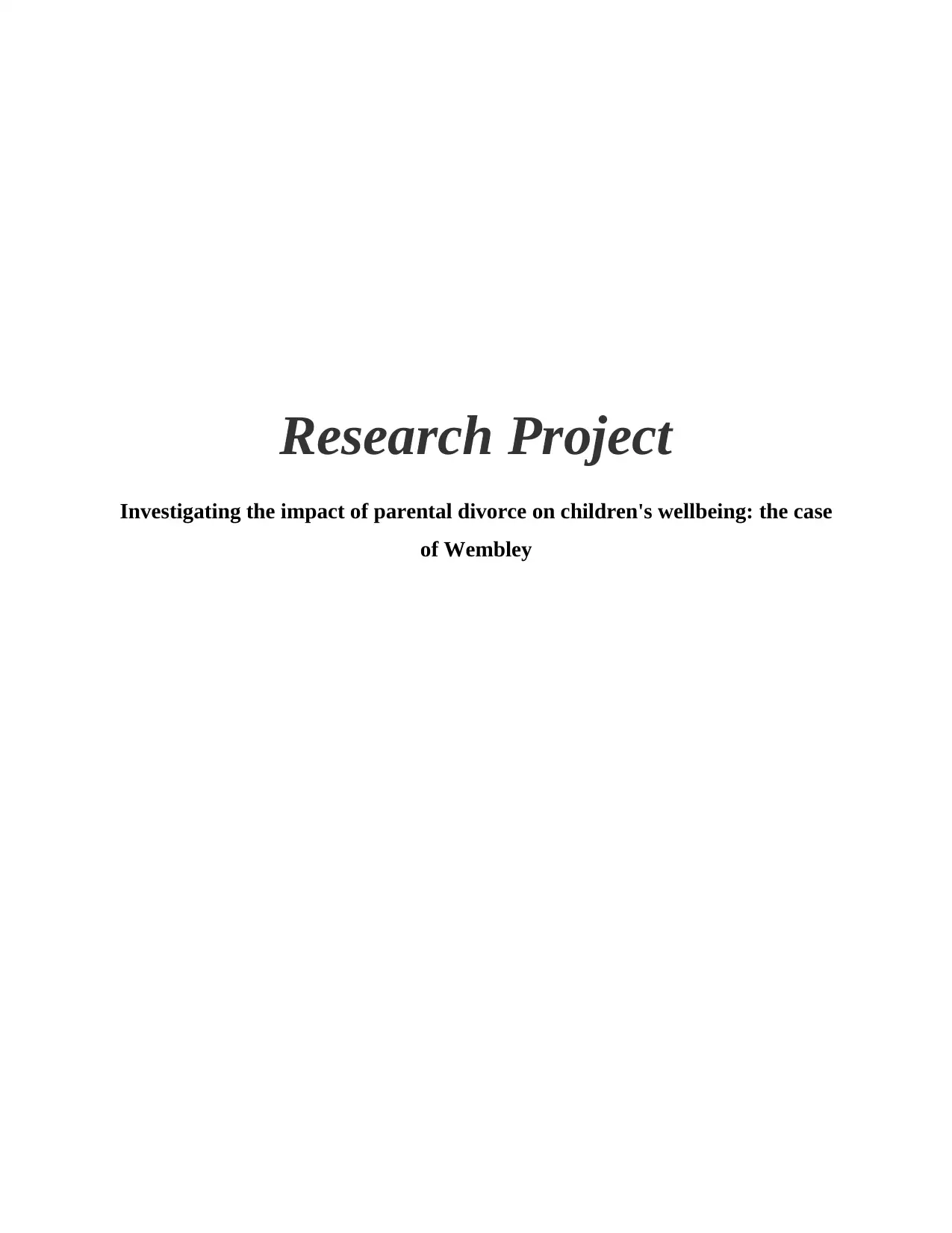
Research Project
Investigating the impact of parental divorce on children's wellbeing: the case
of Wembley
Investigating the impact of parental divorce on children's wellbeing: the case
of Wembley
Paraphrase This Document
Need a fresh take? Get an instant paraphrase of this document with our AI Paraphraser
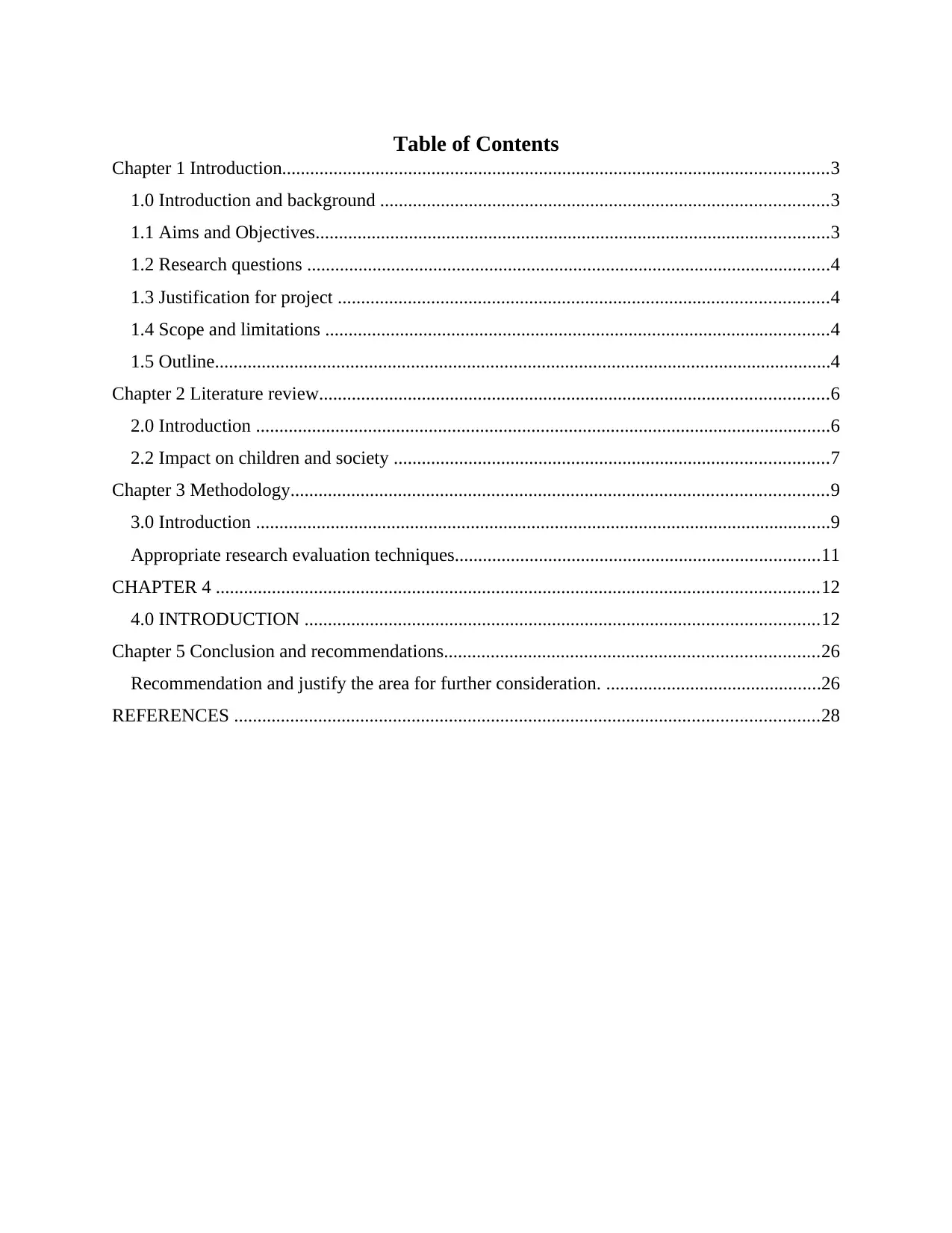
Table of Contents
Chapter 1 Introduction.....................................................................................................................3
1.0 Introduction and background ................................................................................................3
1.1 Aims and Objectives..............................................................................................................3
1.2 Research questions ................................................................................................................4
1.3 Justification for project .........................................................................................................4
1.4 Scope and limitations ............................................................................................................4
1.5 Outline....................................................................................................................................4
Chapter 2 Literature review.............................................................................................................6
2.0 Introduction ...........................................................................................................................6
2.2 Impact on children and society .............................................................................................7
Chapter 3 Methodology...................................................................................................................9
3.0 Introduction ...........................................................................................................................9
Appropriate research evaluation techniques..............................................................................11
CHAPTER 4 .................................................................................................................................12
4.0 INTRODUCTION ..............................................................................................................12
Chapter 5 Conclusion and recommendations................................................................................26
Recommendation and justify the area for further consideration. ..............................................26
REFERENCES .............................................................................................................................28
Chapter 1 Introduction.....................................................................................................................3
1.0 Introduction and background ................................................................................................3
1.1 Aims and Objectives..............................................................................................................3
1.2 Research questions ................................................................................................................4
1.3 Justification for project .........................................................................................................4
1.4 Scope and limitations ............................................................................................................4
1.5 Outline....................................................................................................................................4
Chapter 2 Literature review.............................................................................................................6
2.0 Introduction ...........................................................................................................................6
2.2 Impact on children and society .............................................................................................7
Chapter 3 Methodology...................................................................................................................9
3.0 Introduction ...........................................................................................................................9
Appropriate research evaluation techniques..............................................................................11
CHAPTER 4 .................................................................................................................................12
4.0 INTRODUCTION ..............................................................................................................12
Chapter 5 Conclusion and recommendations................................................................................26
Recommendation and justify the area for further consideration. ..............................................26
REFERENCES .............................................................................................................................28
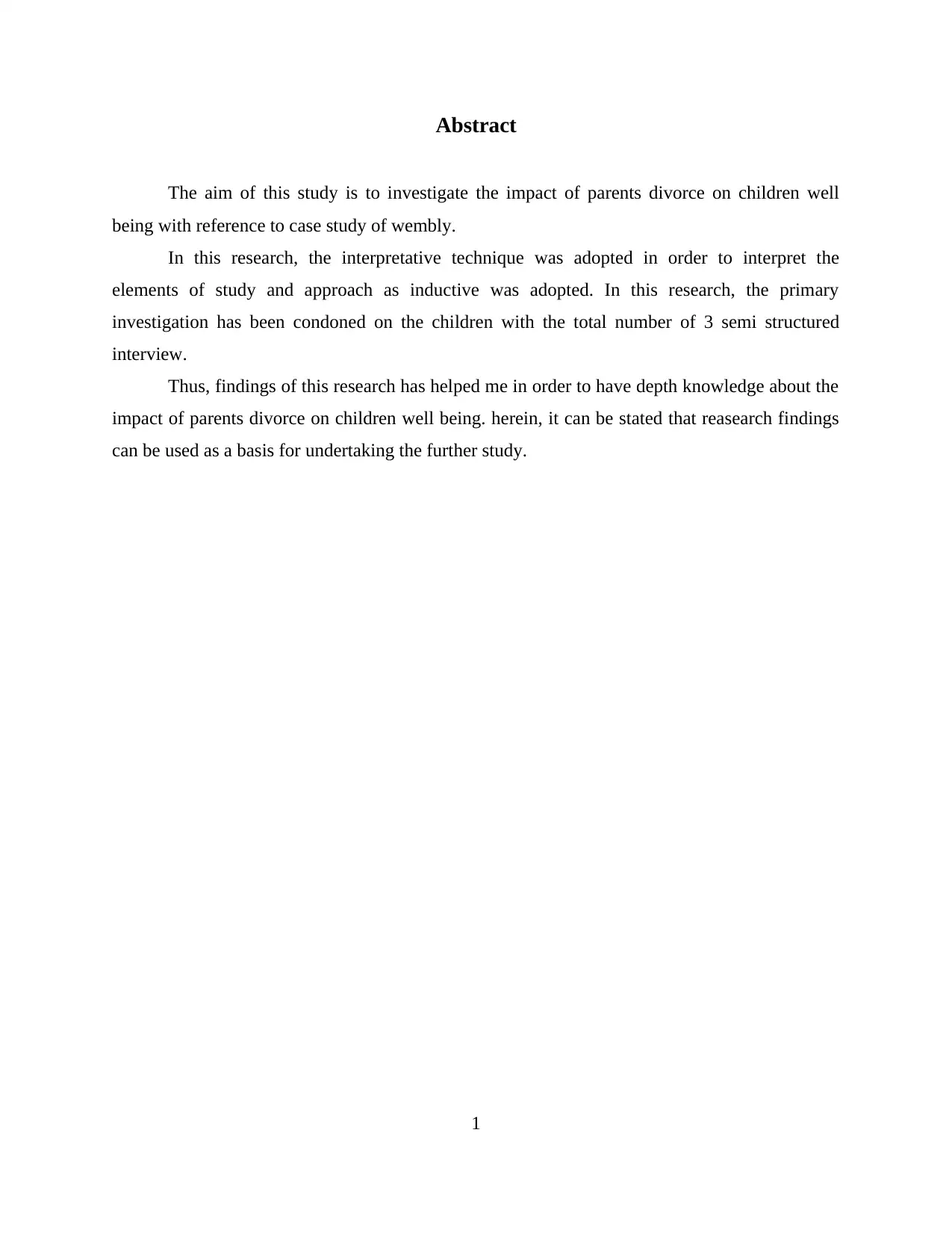
Abstract
The aim of this study is to investigate the impact of parents divorce on children well
being with reference to case study of wembly.
In this research, the interpretative technique was adopted in order to interpret the
elements of study and approach as inductive was adopted. In this research, the primary
investigation has been condoned on the children with the total number of 3 semi structured
interview.
Thus, findings of this research has helped me in order to have depth knowledge about the
impact of parents divorce on children well being. herein, it can be stated that reasearch findings
can be used as a basis for undertaking the further study.
1
The aim of this study is to investigate the impact of parents divorce on children well
being with reference to case study of wembly.
In this research, the interpretative technique was adopted in order to interpret the
elements of study and approach as inductive was adopted. In this research, the primary
investigation has been condoned on the children with the total number of 3 semi structured
interview.
Thus, findings of this research has helped me in order to have depth knowledge about the
impact of parents divorce on children well being. herein, it can be stated that reasearch findings
can be used as a basis for undertaking the further study.
1
⊘ This is a preview!⊘
Do you want full access?
Subscribe today to unlock all pages.

Trusted by 1+ million students worldwide
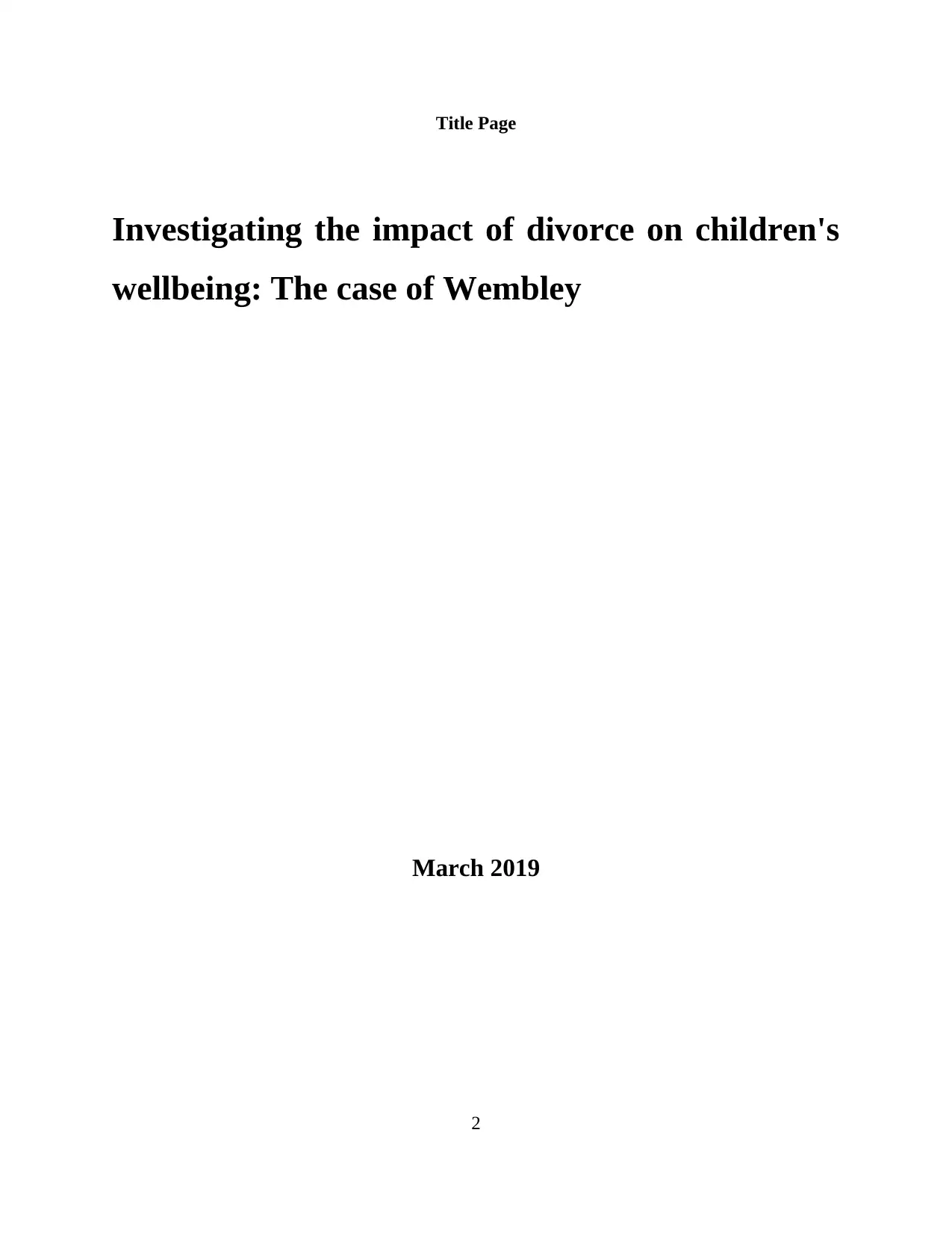
Title Page
Investigating the impact of divorce on children's
wellbeing: The case of Wembley
March 2019
2
Investigating the impact of divorce on children's
wellbeing: The case of Wembley
March 2019
2
Paraphrase This Document
Need a fresh take? Get an instant paraphrase of this document with our AI Paraphraser
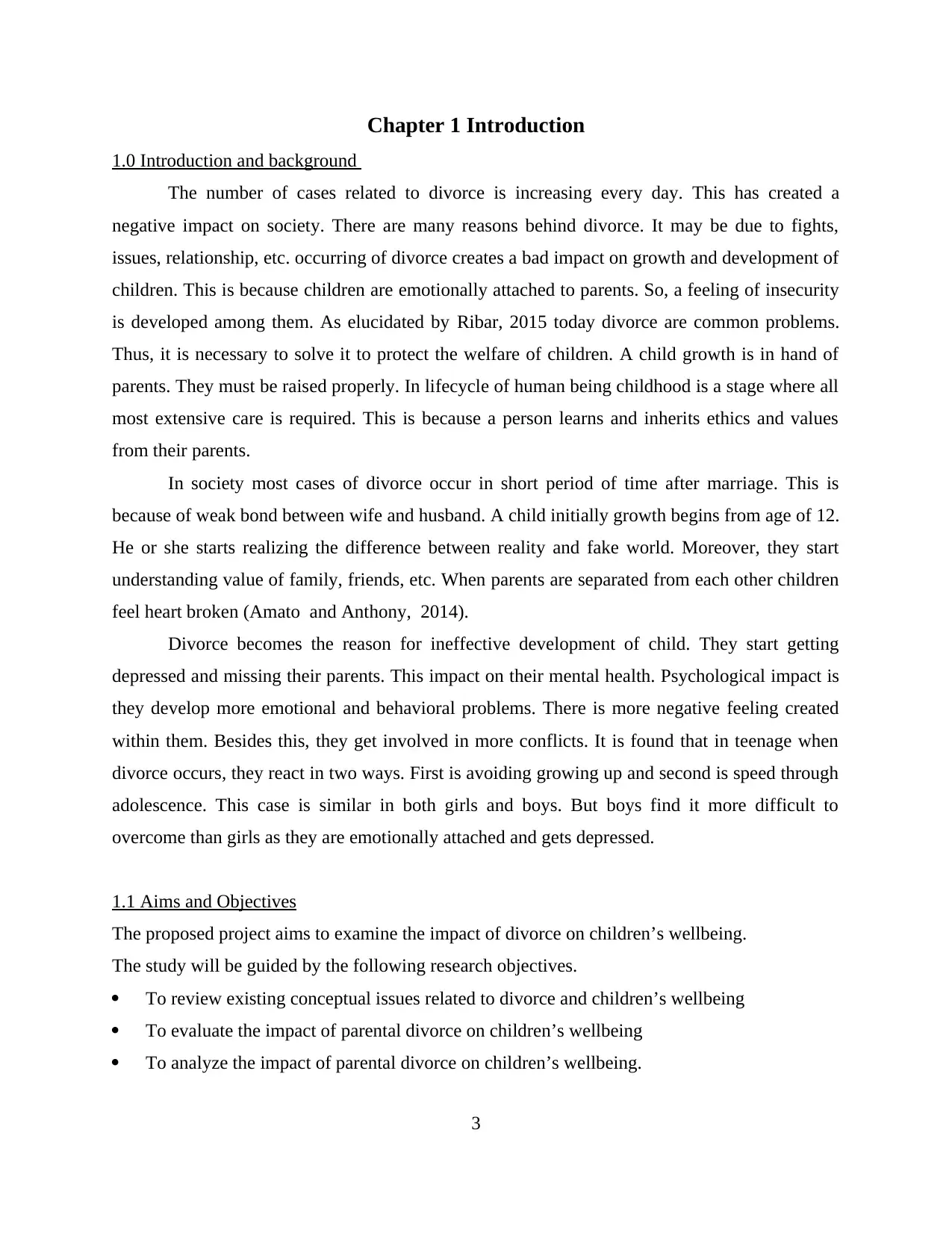
Chapter 1 Introduction
1.0 Introduction and background
The number of cases related to divorce is increasing every day. This has created a
negative impact on society. There are many reasons behind divorce. It may be due to fights,
issues, relationship, etc. occurring of divorce creates a bad impact on growth and development of
children. This is because children are emotionally attached to parents. So, a feeling of insecurity
is developed among them. As elucidated by Ribar, 2015 today divorce are common problems.
Thus, it is necessary to solve it to protect the welfare of children. A child growth is in hand of
parents. They must be raised properly. In lifecycle of human being childhood is a stage where all
most extensive care is required. This is because a person learns and inherits ethics and values
from their parents.
In society most cases of divorce occur in short period of time after marriage. This is
because of weak bond between wife and husband. A child initially growth begins from age of 12.
He or she starts realizing the difference between reality and fake world. Moreover, they start
understanding value of family, friends, etc. When parents are separated from each other children
feel heart broken (Amato and Anthony, 2014).
Divorce becomes the reason for ineffective development of child. They start getting
depressed and missing their parents. This impact on their mental health. Psychological impact is
they develop more emotional and behavioral problems. There is more negative feeling created
within them. Besides this, they get involved in more conflicts. It is found that in teenage when
divorce occurs, they react in two ways. First is avoiding growing up and second is speed through
adolescence. This case is similar in both girls and boys. But boys find it more difficult to
overcome than girls as they are emotionally attached and gets depressed.
1.1 Aims and Objectives
The proposed project aims to examine the impact of divorce on children’s wellbeing.
The study will be guided by the following research objectives.
To review existing conceptual issues related to divorce and children’s wellbeing
To evaluate the impact of parental divorce on children’s wellbeing
To analyze the impact of parental divorce on children’s wellbeing.
3
1.0 Introduction and background
The number of cases related to divorce is increasing every day. This has created a
negative impact on society. There are many reasons behind divorce. It may be due to fights,
issues, relationship, etc. occurring of divorce creates a bad impact on growth and development of
children. This is because children are emotionally attached to parents. So, a feeling of insecurity
is developed among them. As elucidated by Ribar, 2015 today divorce are common problems.
Thus, it is necessary to solve it to protect the welfare of children. A child growth is in hand of
parents. They must be raised properly. In lifecycle of human being childhood is a stage where all
most extensive care is required. This is because a person learns and inherits ethics and values
from their parents.
In society most cases of divorce occur in short period of time after marriage. This is
because of weak bond between wife and husband. A child initially growth begins from age of 12.
He or she starts realizing the difference between reality and fake world. Moreover, they start
understanding value of family, friends, etc. When parents are separated from each other children
feel heart broken (Amato and Anthony, 2014).
Divorce becomes the reason for ineffective development of child. They start getting
depressed and missing their parents. This impact on their mental health. Psychological impact is
they develop more emotional and behavioral problems. There is more negative feeling created
within them. Besides this, they get involved in more conflicts. It is found that in teenage when
divorce occurs, they react in two ways. First is avoiding growing up and second is speed through
adolescence. This case is similar in both girls and boys. But boys find it more difficult to
overcome than girls as they are emotionally attached and gets depressed.
1.1 Aims and Objectives
The proposed project aims to examine the impact of divorce on children’s wellbeing.
The study will be guided by the following research objectives.
To review existing conceptual issues related to divorce and children’s wellbeing
To evaluate the impact of parental divorce on children’s wellbeing
To analyze the impact of parental divorce on children’s wellbeing.
3
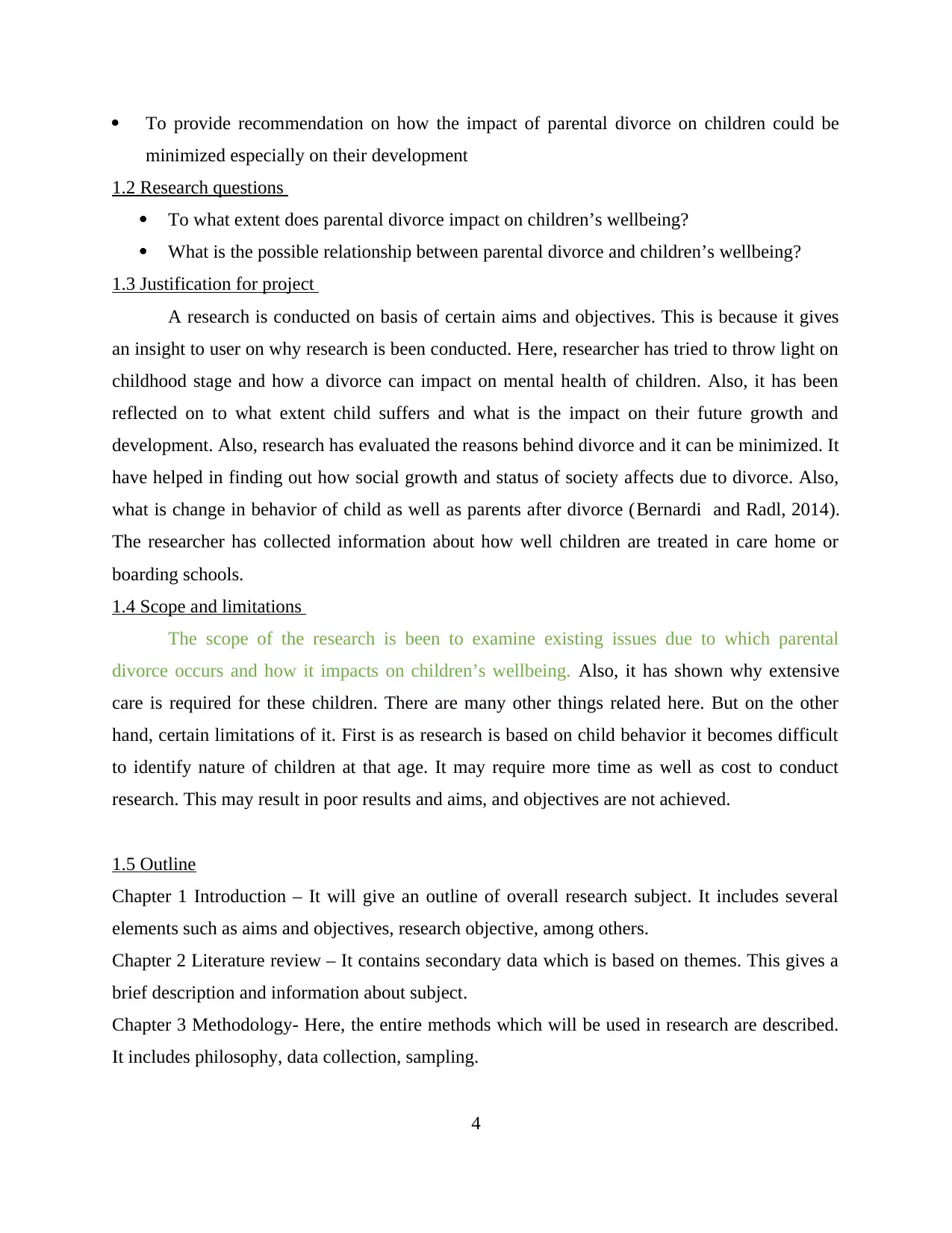
To provide recommendation on how the impact of parental divorce on children could be
minimized especially on their development
1.2 Research questions
To what extent does parental divorce impact on children’s wellbeing?
What is the possible relationship between parental divorce and children’s wellbeing?
1.3 Justification for project
A research is conducted on basis of certain aims and objectives. This is because it gives
an insight to user on why research is been conducted. Here, researcher has tried to throw light on
childhood stage and how a divorce can impact on mental health of children. Also, it has been
reflected on to what extent child suffers and what is the impact on their future growth and
development. Also, research has evaluated the reasons behind divorce and it can be minimized. It
have helped in finding out how social growth and status of society affects due to divorce. Also,
what is change in behavior of child as well as parents after divorce (Bernardi and Radl, 2014).
The researcher has collected information about how well children are treated in care home or
boarding schools.
1.4 Scope and limitations
The scope of the research is been to examine existing issues due to which parental
divorce occurs and how it impacts on children’s wellbeing. Also, it has shown why extensive
care is required for these children. There are many other things related here. But on the other
hand, certain limitations of it. First is as research is based on child behavior it becomes difficult
to identify nature of children at that age. It may require more time as well as cost to conduct
research. This may result in poor results and aims, and objectives are not achieved.
1.5 Outline
Chapter 1 Introduction – It will give an outline of overall research subject. It includes several
elements such as aims and objectives, research objective, among others.
Chapter 2 Literature review – It contains secondary data which is based on themes. This gives a
brief description and information about subject.
Chapter 3 Methodology- Here, the entire methods which will be used in research are described.
It includes philosophy, data collection, sampling.
4
minimized especially on their development
1.2 Research questions
To what extent does parental divorce impact on children’s wellbeing?
What is the possible relationship between parental divorce and children’s wellbeing?
1.3 Justification for project
A research is conducted on basis of certain aims and objectives. This is because it gives
an insight to user on why research is been conducted. Here, researcher has tried to throw light on
childhood stage and how a divorce can impact on mental health of children. Also, it has been
reflected on to what extent child suffers and what is the impact on their future growth and
development. Also, research has evaluated the reasons behind divorce and it can be minimized. It
have helped in finding out how social growth and status of society affects due to divorce. Also,
what is change in behavior of child as well as parents after divorce (Bernardi and Radl, 2014).
The researcher has collected information about how well children are treated in care home or
boarding schools.
1.4 Scope and limitations
The scope of the research is been to examine existing issues due to which parental
divorce occurs and how it impacts on children’s wellbeing. Also, it has shown why extensive
care is required for these children. There are many other things related here. But on the other
hand, certain limitations of it. First is as research is based on child behavior it becomes difficult
to identify nature of children at that age. It may require more time as well as cost to conduct
research. This may result in poor results and aims, and objectives are not achieved.
1.5 Outline
Chapter 1 Introduction – It will give an outline of overall research subject. It includes several
elements such as aims and objectives, research objective, among others.
Chapter 2 Literature review – It contains secondary data which is based on themes. This gives a
brief description and information about subject.
Chapter 3 Methodology- Here, the entire methods which will be used in research are described.
It includes philosophy, data collection, sampling.
4
⊘ This is a preview!⊘
Do you want full access?
Subscribe today to unlock all pages.

Trusted by 1+ million students worldwide
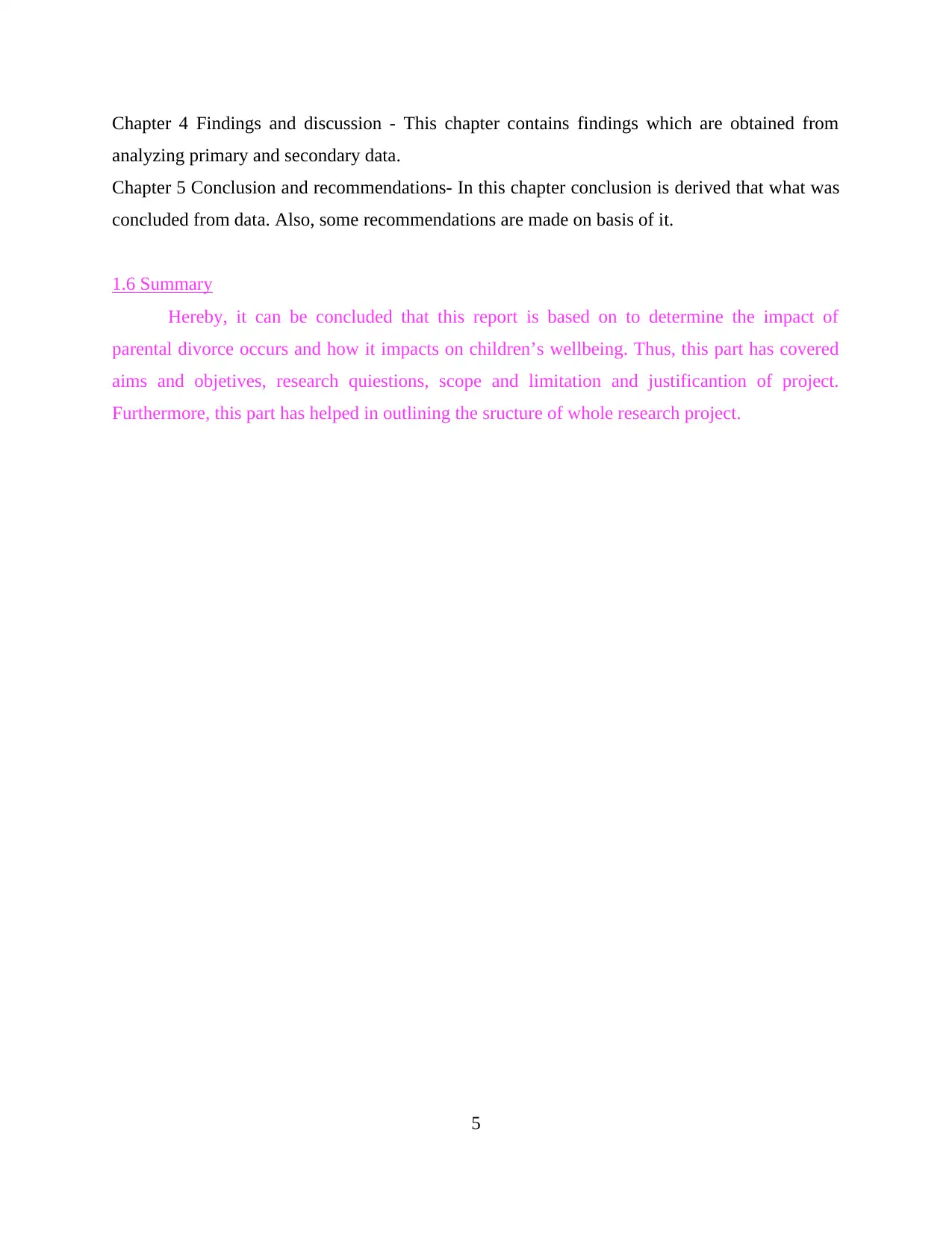
Chapter 4 Findings and discussion - This chapter contains findings which are obtained from
analyzing primary and secondary data.
Chapter 5 Conclusion and recommendations- In this chapter conclusion is derived that what was
concluded from data. Also, some recommendations are made on basis of it.
1.6 Summary
Hereby, it can be concluded that this report is based on to determine the impact of
parental divorce occurs and how it impacts on children’s wellbeing. Thus, this part has covered
aims and objetives, research quiestions, scope and limitation and justificantion of project.
Furthermore, this part has helped in outlining the sructure of whole research project.
5
analyzing primary and secondary data.
Chapter 5 Conclusion and recommendations- In this chapter conclusion is derived that what was
concluded from data. Also, some recommendations are made on basis of it.
1.6 Summary
Hereby, it can be concluded that this report is based on to determine the impact of
parental divorce occurs and how it impacts on children’s wellbeing. Thus, this part has covered
aims and objetives, research quiestions, scope and limitation and justificantion of project.
Furthermore, this part has helped in outlining the sructure of whole research project.
5
Paraphrase This Document
Need a fresh take? Get an instant paraphrase of this document with our AI Paraphraser
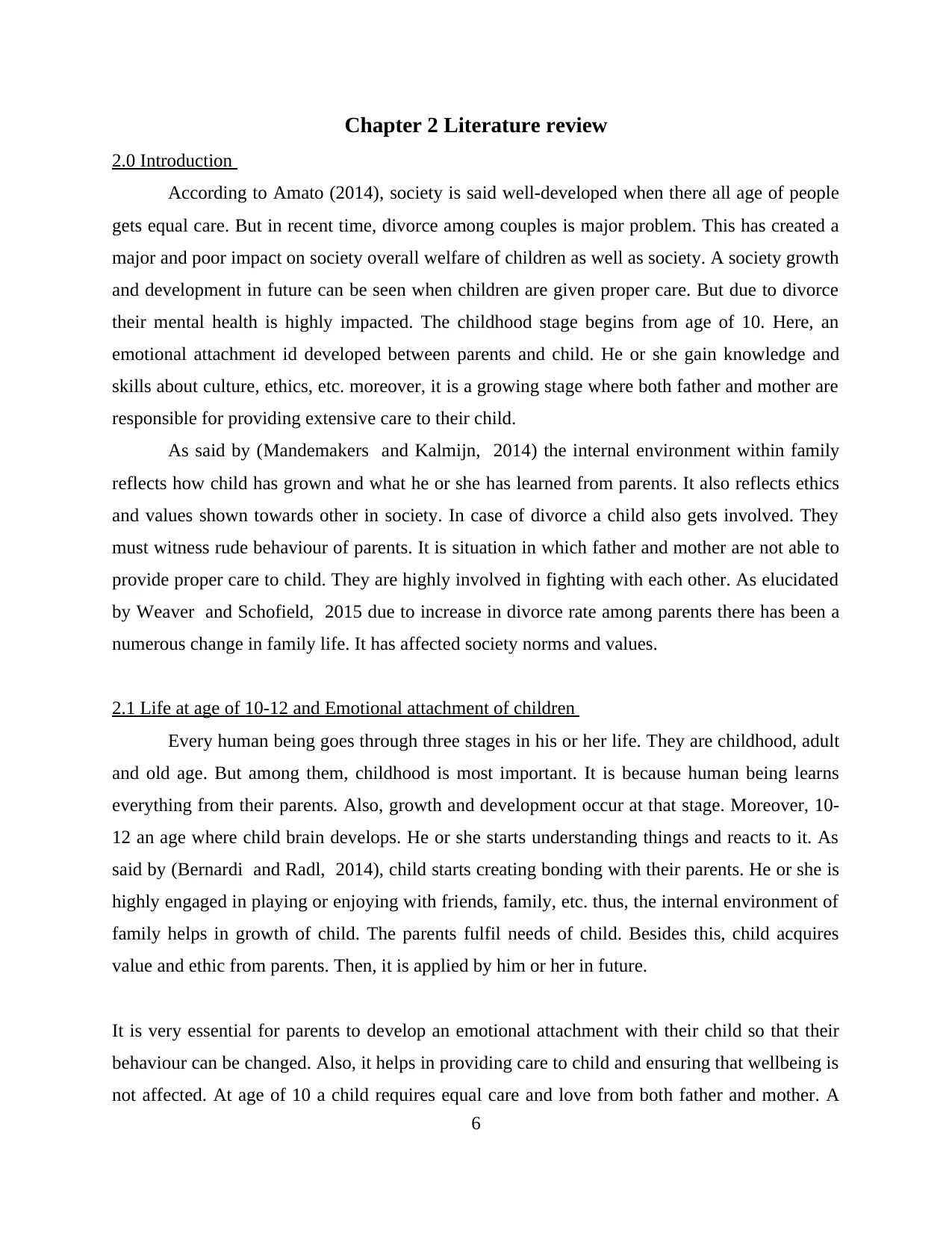
Chapter 2 Literature review
2.0 Introduction
According to Amato (2014), society is said well-developed when there all age of people
gets equal care. But in recent time, divorce among couples is major problem. This has created a
major and poor impact on society overall welfare of children as well as society. A society growth
and development in future can be seen when children are given proper care. But due to divorce
their mental health is highly impacted. The childhood stage begins from age of 10. Here, an
emotional attachment id developed between parents and child. He or she gain knowledge and
skills about culture, ethics, etc. moreover, it is a growing stage where both father and mother are
responsible for providing extensive care to their child.
As said by (Mandemakers and Kalmijn, 2014) the internal environment within family
reflects how child has grown and what he or she has learned from parents. It also reflects ethics
and values shown towards other in society. In case of divorce a child also gets involved. They
must witness rude behaviour of parents. It is situation in which father and mother are not able to
provide proper care to child. They are highly involved in fighting with each other. As elucidated
by Weaver and Schofield, 2015 due to increase in divorce rate among parents there has been a
numerous change in family life. It has affected society norms and values.
2.1 Life at age of 10-12 and Emotional attachment of children
Every human being goes through three stages in his or her life. They are childhood, adult
and old age. But among them, childhood is most important. It is because human being learns
everything from their parents. Also, growth and development occur at that stage. Moreover, 10-
12 an age where child brain develops. He or she starts understanding things and reacts to it. As
said by (Bernardi and Radl, 2014), child starts creating bonding with their parents. He or she is
highly engaged in playing or enjoying with friends, family, etc. thus, the internal environment of
family helps in growth of child. The parents fulfil needs of child. Besides this, child acquires
value and ethic from parents. Then, it is applied by him or her in future.
It is very essential for parents to develop an emotional attachment with their child so that their
behaviour can be changed. Also, it helps in providing care to child and ensuring that wellbeing is
not affected. At age of 10 a child requires equal care and love from both father and mother. A
6
2.0 Introduction
According to Amato (2014), society is said well-developed when there all age of people
gets equal care. But in recent time, divorce among couples is major problem. This has created a
major and poor impact on society overall welfare of children as well as society. A society growth
and development in future can be seen when children are given proper care. But due to divorce
their mental health is highly impacted. The childhood stage begins from age of 10. Here, an
emotional attachment id developed between parents and child. He or she gain knowledge and
skills about culture, ethics, etc. moreover, it is a growing stage where both father and mother are
responsible for providing extensive care to their child.
As said by (Mandemakers and Kalmijn, 2014) the internal environment within family
reflects how child has grown and what he or she has learned from parents. It also reflects ethics
and values shown towards other in society. In case of divorce a child also gets involved. They
must witness rude behaviour of parents. It is situation in which father and mother are not able to
provide proper care to child. They are highly involved in fighting with each other. As elucidated
by Weaver and Schofield, 2015 due to increase in divorce rate among parents there has been a
numerous change in family life. It has affected society norms and values.
2.1 Life at age of 10-12 and Emotional attachment of children
Every human being goes through three stages in his or her life. They are childhood, adult
and old age. But among them, childhood is most important. It is because human being learns
everything from their parents. Also, growth and development occur at that stage. Moreover, 10-
12 an age where child brain develops. He or she starts understanding things and reacts to it. As
said by (Bernardi and Radl, 2014), child starts creating bonding with their parents. He or she is
highly engaged in playing or enjoying with friends, family, etc. thus, the internal environment of
family helps in growth of child. The parents fulfil needs of child. Besides this, child acquires
value and ethic from parents. Then, it is applied by him or her in future.
It is very essential for parents to develop an emotional attachment with their child so that their
behaviour can be changed. Also, it helps in providing care to child and ensuring that wellbeing is
not affected. At age of 10 a child requires equal care and love from both father and mother. A
6
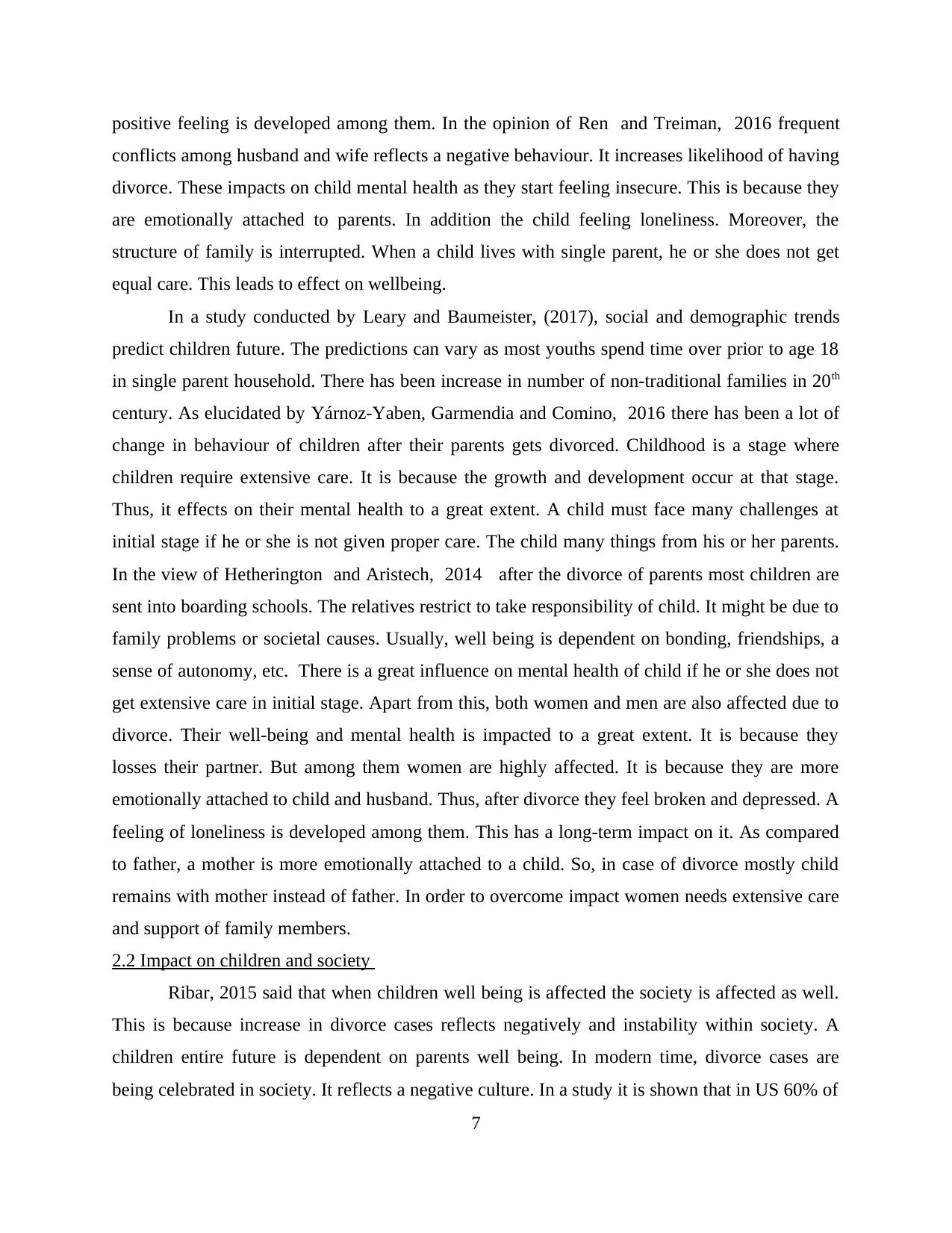
positive feeling is developed among them. In the opinion of Ren and Treiman, 2016 frequent
conflicts among husband and wife reflects a negative behaviour. It increases likelihood of having
divorce. These impacts on child mental health as they start feeling insecure. This is because they
are emotionally attached to parents. In addition the child feeling loneliness. Moreover, the
structure of family is interrupted. When a child lives with single parent, he or she does not get
equal care. This leads to effect on wellbeing.
In a study conducted by Leary and Baumeister, (2017), social and demographic trends
predict children future. The predictions can vary as most youths spend time over prior to age 18
in single parent household. There has been increase in number of non-traditional families in 20th
century. As elucidated by Yárnoz-Yaben, Garmendia and Comino, 2016 there has been a lot of
change in behaviour of children after their parents gets divorced. Childhood is a stage where
children require extensive care. It is because the growth and development occur at that stage.
Thus, it effects on their mental health to a great extent. A child must face many challenges at
initial stage if he or she is not given proper care. The child many things from his or her parents.
In the view of Hetherington and Aristech, 2014 after the divorce of parents most children are
sent into boarding schools. The relatives restrict to take responsibility of child. It might be due to
family problems or societal causes. Usually, well being is dependent on bonding, friendships, a
sense of autonomy, etc. There is a great influence on mental health of child if he or she does not
get extensive care in initial stage. Apart from this, both women and men are also affected due to
divorce. Their well-being and mental health is impacted to a great extent. It is because they
losses their partner. But among them women are highly affected. It is because they are more
emotionally attached to child and husband. Thus, after divorce they feel broken and depressed. A
feeling of loneliness is developed among them. This has a long-term impact on it. As compared
to father, a mother is more emotionally attached to a child. So, in case of divorce mostly child
remains with mother instead of father. In order to overcome impact women needs extensive care
and support of family members.
2.2 Impact on children and society
Ribar, 2015 said that when children well being is affected the society is affected as well.
This is because increase in divorce cases reflects negatively and instability within society. A
children entire future is dependent on parents well being. In modern time, divorce cases are
being celebrated in society. It reflects a negative culture. In a study it is shown that in US 60% of
7
conflicts among husband and wife reflects a negative behaviour. It increases likelihood of having
divorce. These impacts on child mental health as they start feeling insecure. This is because they
are emotionally attached to parents. In addition the child feeling loneliness. Moreover, the
structure of family is interrupted. When a child lives with single parent, he or she does not get
equal care. This leads to effect on wellbeing.
In a study conducted by Leary and Baumeister, (2017), social and demographic trends
predict children future. The predictions can vary as most youths spend time over prior to age 18
in single parent household. There has been increase in number of non-traditional families in 20th
century. As elucidated by Yárnoz-Yaben, Garmendia and Comino, 2016 there has been a lot of
change in behaviour of children after their parents gets divorced. Childhood is a stage where
children require extensive care. It is because the growth and development occur at that stage.
Thus, it effects on their mental health to a great extent. A child must face many challenges at
initial stage if he or she is not given proper care. The child many things from his or her parents.
In the view of Hetherington and Aristech, 2014 after the divorce of parents most children are
sent into boarding schools. The relatives restrict to take responsibility of child. It might be due to
family problems or societal causes. Usually, well being is dependent on bonding, friendships, a
sense of autonomy, etc. There is a great influence on mental health of child if he or she does not
get extensive care in initial stage. Apart from this, both women and men are also affected due to
divorce. Their well-being and mental health is impacted to a great extent. It is because they
losses their partner. But among them women are highly affected. It is because they are more
emotionally attached to child and husband. Thus, after divorce they feel broken and depressed. A
feeling of loneliness is developed among them. This has a long-term impact on it. As compared
to father, a mother is more emotionally attached to a child. So, in case of divorce mostly child
remains with mother instead of father. In order to overcome impact women needs extensive care
and support of family members.
2.2 Impact on children and society
Ribar, 2015 said that when children well being is affected the society is affected as well.
This is because increase in divorce cases reflects negatively and instability within society. A
children entire future is dependent on parents well being. In modern time, divorce cases are
being celebrated in society. It reflects a negative culture. In a study it is shown that in US 60% of
7
⊘ This is a preview!⊘
Do you want full access?
Subscribe today to unlock all pages.

Trusted by 1+ million students worldwide
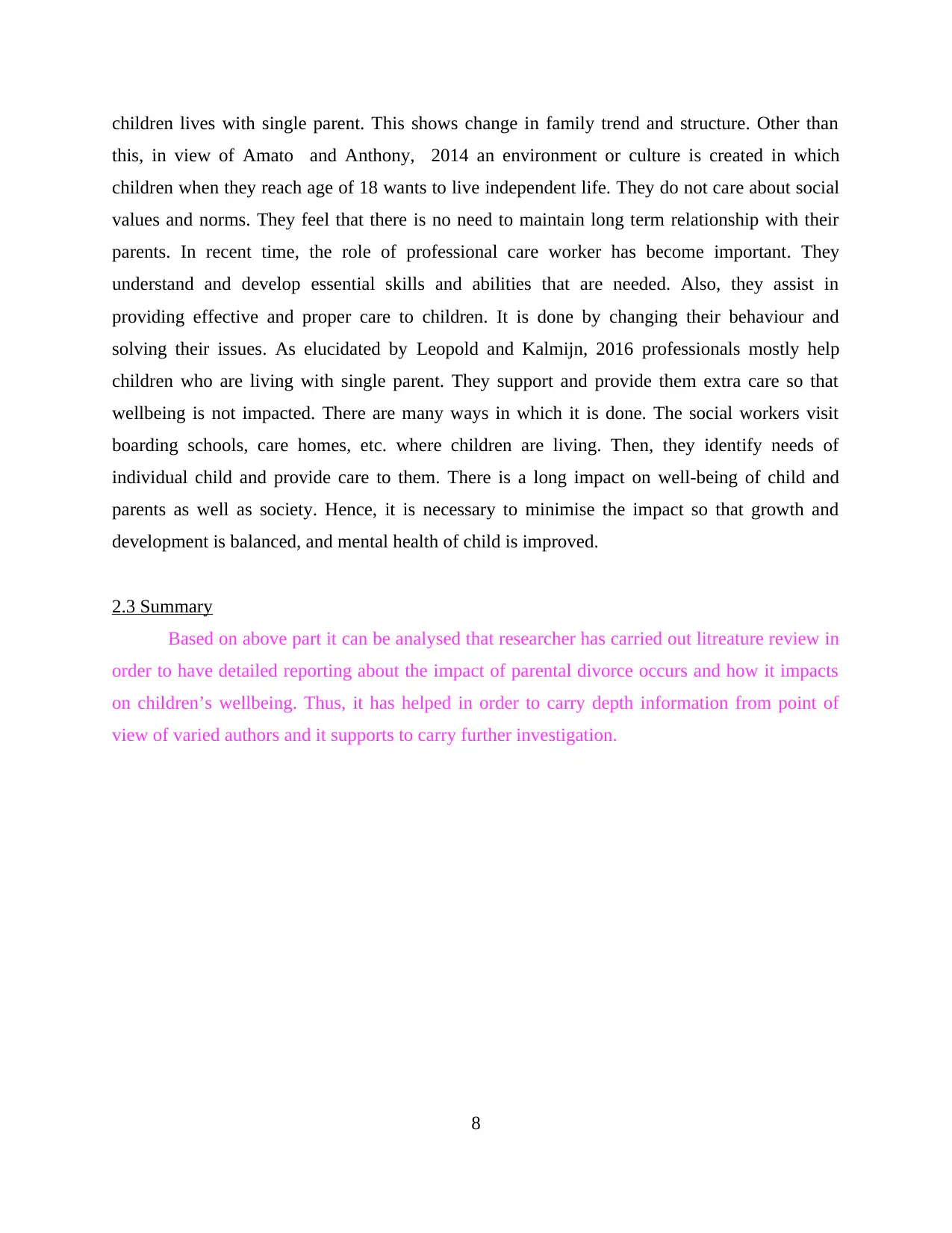
children lives with single parent. This shows change in family trend and structure. Other than
this, in view of Amato and Anthony, 2014 an environment or culture is created in which
children when they reach age of 18 wants to live independent life. They do not care about social
values and norms. They feel that there is no need to maintain long term relationship with their
parents. In recent time, the role of professional care worker has become important. They
understand and develop essential skills and abilities that are needed. Also, they assist in
providing effective and proper care to children. It is done by changing their behaviour and
solving their issues. As elucidated by Leopold and Kalmijn, 2016 professionals mostly help
children who are living with single parent. They support and provide them extra care so that
wellbeing is not impacted. There are many ways in which it is done. The social workers visit
boarding schools, care homes, etc. where children are living. Then, they identify needs of
individual child and provide care to them. There is a long impact on well-being of child and
parents as well as society. Hence, it is necessary to minimise the impact so that growth and
development is balanced, and mental health of child is improved.
2.3 Summary
Based on above part it can be analysed that researcher has carried out litreature review in
order to have detailed reporting about the impact of parental divorce occurs and how it impacts
on children’s wellbeing. Thus, it has helped in order to carry depth information from point of
view of varied authors and it supports to carry further investigation.
8
this, in view of Amato and Anthony, 2014 an environment or culture is created in which
children when they reach age of 18 wants to live independent life. They do not care about social
values and norms. They feel that there is no need to maintain long term relationship with their
parents. In recent time, the role of professional care worker has become important. They
understand and develop essential skills and abilities that are needed. Also, they assist in
providing effective and proper care to children. It is done by changing their behaviour and
solving their issues. As elucidated by Leopold and Kalmijn, 2016 professionals mostly help
children who are living with single parent. They support and provide them extra care so that
wellbeing is not impacted. There are many ways in which it is done. The social workers visit
boarding schools, care homes, etc. where children are living. Then, they identify needs of
individual child and provide care to them. There is a long impact on well-being of child and
parents as well as society. Hence, it is necessary to minimise the impact so that growth and
development is balanced, and mental health of child is improved.
2.3 Summary
Based on above part it can be analysed that researcher has carried out litreature review in
order to have detailed reporting about the impact of parental divorce occurs and how it impacts
on children’s wellbeing. Thus, it has helped in order to carry depth information from point of
view of varied authors and it supports to carry further investigation.
8
Paraphrase This Document
Need a fresh take? Get an instant paraphrase of this document with our AI Paraphraser
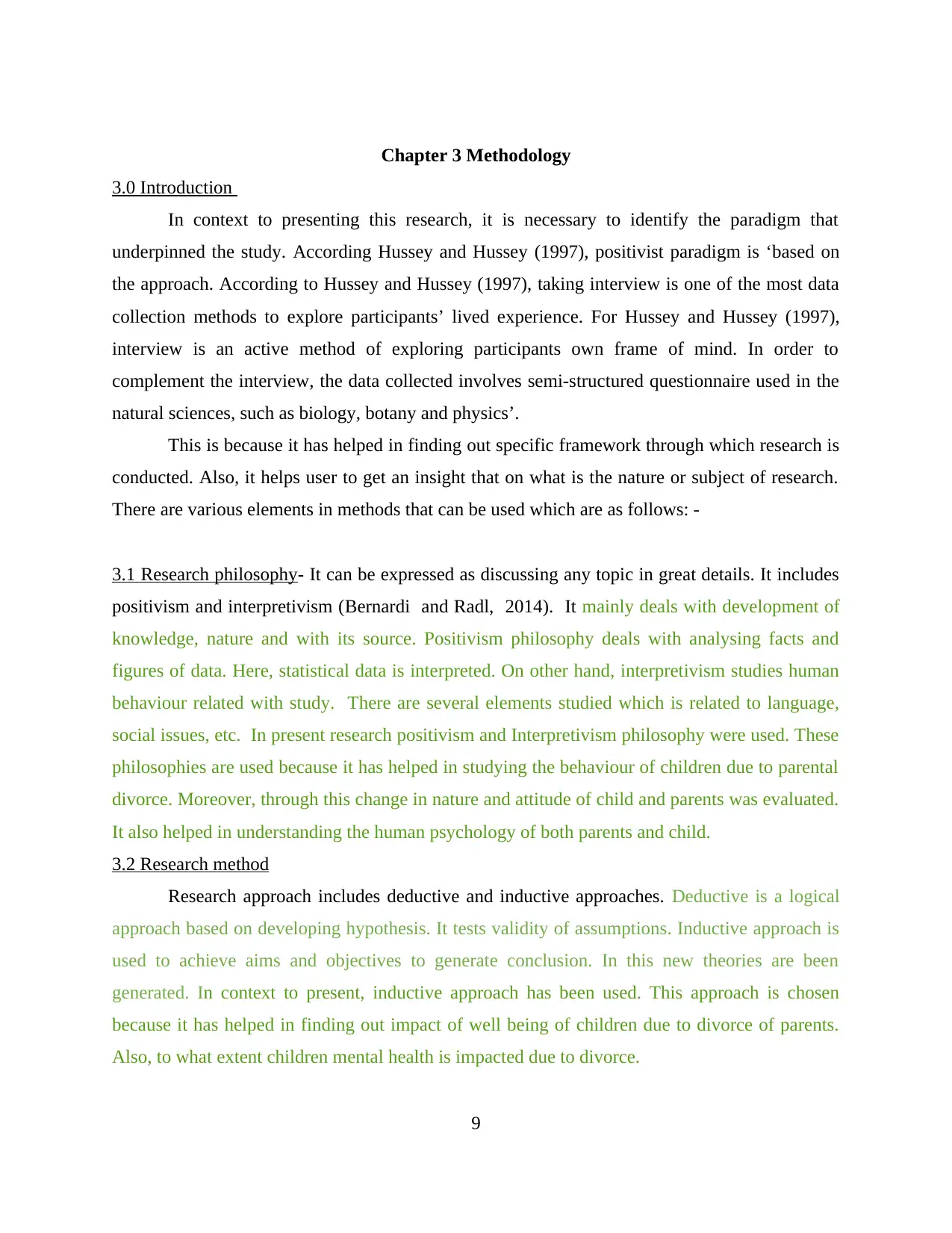
Chapter 3 Methodology
3.0 Introduction
In context to presenting this research, it is necessary to identify the paradigm that
underpinned the study. According Hussey and Hussey (1997), positivist paradigm is ‘based on
the approach. According to Hussey and Hussey (1997), taking interview is one of the most data
collection methods to explore participants’ lived experience. For Hussey and Hussey (1997),
interview is an active method of exploring participants own frame of mind. In order to
complement the interview, the data collected involves semi-structured questionnaire used in the
natural sciences, such as biology, botany and physics’.
This is because it has helped in finding out specific framework through which research is
conducted. Also, it helps user to get an insight that on what is the nature or subject of research.
There are various elements in methods that can be used which are as follows: -
3.1 Research philosophy- It can be expressed as discussing any topic in great details. It includes
positivism and interpretivism (Bernardi and Radl, 2014). It mainly deals with development of
knowledge, nature and with its source. Positivism philosophy deals with analysing facts and
figures of data. Here, statistical data is interpreted. On other hand, interpretivism studies human
behaviour related with study. There are several elements studied which is related to language,
social issues, etc. In present research positivism and Interpretivism philosophy were used. These
philosophies are used because it has helped in studying the behaviour of children due to parental
divorce. Moreover, through this change in nature and attitude of child and parents was evaluated.
It also helped in understanding the human psychology of both parents and child.
3.2 Research method
Research approach includes deductive and inductive approaches. Deductive is a logical
approach based on developing hypothesis. It tests validity of assumptions. Inductive approach is
used to achieve aims and objectives to generate conclusion. In this new theories are been
generated. In context to present, inductive approach has been used. This approach is chosen
because it has helped in finding out impact of well being of children due to divorce of parents.
Also, to what extent children mental health is impacted due to divorce.
9
3.0 Introduction
In context to presenting this research, it is necessary to identify the paradigm that
underpinned the study. According Hussey and Hussey (1997), positivist paradigm is ‘based on
the approach. According to Hussey and Hussey (1997), taking interview is one of the most data
collection methods to explore participants’ lived experience. For Hussey and Hussey (1997),
interview is an active method of exploring participants own frame of mind. In order to
complement the interview, the data collected involves semi-structured questionnaire used in the
natural sciences, such as biology, botany and physics’.
This is because it has helped in finding out specific framework through which research is
conducted. Also, it helps user to get an insight that on what is the nature or subject of research.
There are various elements in methods that can be used which are as follows: -
3.1 Research philosophy- It can be expressed as discussing any topic in great details. It includes
positivism and interpretivism (Bernardi and Radl, 2014). It mainly deals with development of
knowledge, nature and with its source. Positivism philosophy deals with analysing facts and
figures of data. Here, statistical data is interpreted. On other hand, interpretivism studies human
behaviour related with study. There are several elements studied which is related to language,
social issues, etc. In present research positivism and Interpretivism philosophy were used. These
philosophies are used because it has helped in studying the behaviour of children due to parental
divorce. Moreover, through this change in nature and attitude of child and parents was evaluated.
It also helped in understanding the human psychology of both parents and child.
3.2 Research method
Research approach includes deductive and inductive approaches. Deductive is a logical
approach based on developing hypothesis. It tests validity of assumptions. Inductive approach is
used to achieve aims and objectives to generate conclusion. In this new theories are been
generated. In context to present, inductive approach has been used. This approach is chosen
because it has helped in finding out impact of well being of children due to divorce of parents.
Also, to what extent children mental health is impacted due to divorce.
9
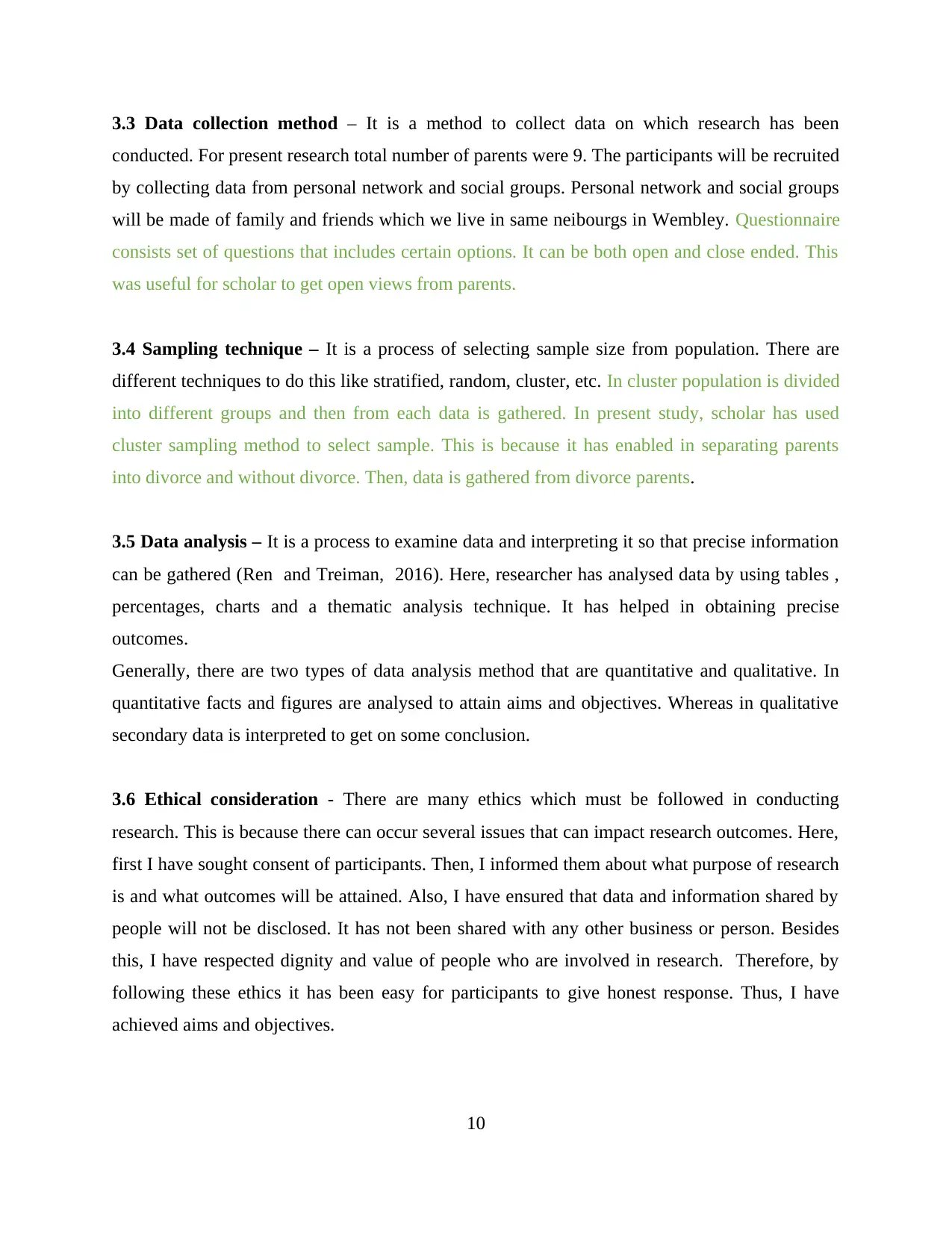
3.3 Data collection method – It is a method to collect data on which research has been
conducted. For present research total number of parents were 9. The participants will be recruited
by collecting data from personal network and social groups. Personal network and social groups
will be made of family and friends which we live in same neibourgs in Wembley. Questionnaire
consists set of questions that includes certain options. It can be both open and close ended. This
was useful for scholar to get open views from parents.
3.4 Sampling technique – It is a process of selecting sample size from population. There are
different techniques to do this like stratified, random, cluster, etc. In cluster population is divided
into different groups and then from each data is gathered. In present study, scholar has used
cluster sampling method to select sample. This is because it has enabled in separating parents
into divorce and without divorce. Then, data is gathered from divorce parents.
3.5 Data analysis – It is a process to examine data and interpreting it so that precise information
can be gathered (Ren and Treiman, 2016). Here, researcher has analysed data by using tables ,
percentages, charts and a thematic analysis technique. It has helped in obtaining precise
outcomes.
Generally, there are two types of data analysis method that are quantitative and qualitative. In
quantitative facts and figures are analysed to attain aims and objectives. Whereas in qualitative
secondary data is interpreted to get on some conclusion.
3.6 Ethical consideration - There are many ethics which must be followed in conducting
research. This is because there can occur several issues that can impact research outcomes. Here,
first I have sought consent of participants. Then, I informed them about what purpose of research
is and what outcomes will be attained. Also, I have ensured that data and information shared by
people will not be disclosed. It has not been shared with any other business or person. Besides
this, I have respected dignity and value of people who are involved in research. Therefore, by
following these ethics it has been easy for participants to give honest response. Thus, I have
achieved aims and objectives.
10
conducted. For present research total number of parents were 9. The participants will be recruited
by collecting data from personal network and social groups. Personal network and social groups
will be made of family and friends which we live in same neibourgs in Wembley. Questionnaire
consists set of questions that includes certain options. It can be both open and close ended. This
was useful for scholar to get open views from parents.
3.4 Sampling technique – It is a process of selecting sample size from population. There are
different techniques to do this like stratified, random, cluster, etc. In cluster population is divided
into different groups and then from each data is gathered. In present study, scholar has used
cluster sampling method to select sample. This is because it has enabled in separating parents
into divorce and without divorce. Then, data is gathered from divorce parents.
3.5 Data analysis – It is a process to examine data and interpreting it so that precise information
can be gathered (Ren and Treiman, 2016). Here, researcher has analysed data by using tables ,
percentages, charts and a thematic analysis technique. It has helped in obtaining precise
outcomes.
Generally, there are two types of data analysis method that are quantitative and qualitative. In
quantitative facts and figures are analysed to attain aims and objectives. Whereas in qualitative
secondary data is interpreted to get on some conclusion.
3.6 Ethical consideration - There are many ethics which must be followed in conducting
research. This is because there can occur several issues that can impact research outcomes. Here,
first I have sought consent of participants. Then, I informed them about what purpose of research
is and what outcomes will be attained. Also, I have ensured that data and information shared by
people will not be disclosed. It has not been shared with any other business or person. Besides
this, I have respected dignity and value of people who are involved in research. Therefore, by
following these ethics it has been easy for participants to give honest response. Thus, I have
achieved aims and objectives.
10
⊘ This is a preview!⊘
Do you want full access?
Subscribe today to unlock all pages.

Trusted by 1+ million students worldwide
1 out of 31
Related Documents
Your All-in-One AI-Powered Toolkit for Academic Success.
+13062052269
info@desklib.com
Available 24*7 on WhatsApp / Email
![[object Object]](/_next/static/media/star-bottom.7253800d.svg)
Unlock your academic potential
Copyright © 2020–2025 A2Z Services. All Rights Reserved. Developed and managed by ZUCOL.





